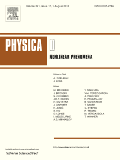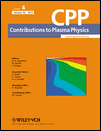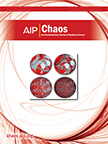
PHYSICA D-NONLINEAR PHENOMENA
Scope & Guideline
Advancing Knowledge in Nonlinear Phenomena
Introduction
Aims and Scopes
- Nonlinear Dynamics:
The journal emphasizes the study of nonlinear dynamical systems, exploring their behaviors, stability, and chaotic dynamics through theoretical and computational approaches. - Soliton and Wave Phenomena:
A significant area of research involves solitons and wave dynamics, including their formation, stability, interactions, and applications in various physical contexts. - Complex Systems and Networks:
Investigations into complex systems, including network dynamics, synchronization phenomena, and collective behaviors of agents, are central to the journal's contributions. - Mathematical Modeling and Analysis:
The journal publishes papers that develop and analyze mathematical models across disciplines, focusing on their analytical solutions, numerical simulations, and implications for real-world systems. - Data-Driven Approaches:
There is a growing emphasis on integrating data-driven methods, such as machine learning and statistical inference, to analyze and predict the behaviors of nonlinear systems. - Applications in Physics and Beyond:
Research published in the journal spans various applications, including fluid dynamics, plasma physics, biological systems, and climate models, demonstrating the versatility of nonlinear phenomena.
Trending and Emerging
- Machine Learning and Data Science:
There is a marked increase in the application of machine learning techniques to analyze complex dynamical systems and to develop predictive models for nonlinear behaviors. - Multiscale and Complex Networks:
Research on multiscale interactions in complex networks is trending, highlighting the interplay between local dynamics and global network behaviors. - Nonlocal Effects and Fractional Dynamics:
Emerging interest in nonlocal interactions and fractional dynamics is evident, as researchers explore new mathematical frameworks to capture phenomena that traditional models cannot adequately describe. - Interdisciplinary Applications:
Papers reflecting interdisciplinary applications of nonlinear dynamics in fields such as biology, climate science, and social dynamics are on the rise, indicating a broader relevance of the journal's scope. - Stochastic Dynamics and Uncertainty Quantification:
Increasingly, researchers are focusing on stochastic models and uncertainty quantification methods to address the inherent unpredictability in complex systems. - Topological and Geometric Methods:
There is a growing interest in employing topological and geometric methods to analyze dynamical systems, revealing insights into stability and bifurcation phenomena.
Declining or Waning
- Classical Integrable Systems:
There has been a noticeable decline in publications focused on classical integrable systems, as researchers increasingly explore more complex and non-integrable dynamics. - Static Models of Dynamics:
Static or equilibrium models are becoming less common as the focus shifts towards dynamic, time-dependent models that capture the complexities of real-world systems. - Traditional Numerical Methods:
The reliance on conventional numerical methods appears to be waning, with a movement towards more sophisticated, adaptive, and data-driven techniques that enhance predictive capabilities. - Simple Chaotic Systems:
Research on simple chaotic systems is declining as the community increasingly investigates higher-dimensional, multi-scale, and coupled chaotic systems that reflect more realistic scenarios.
Similar Journals

WAVE MOTION
Unraveling the Science of Waves: Interdisciplinary InsightsWAVE MOTION is a premier scholarly journal published by Elsevier, dedicated to the interdisciplinary study of wave phenomena across various scientific domains. With an ISSN of 0165-2125 and an E-ISSN of 1878-433X, this journal has been a significant contributor to the field since its inception in 1979, continuing to expand knowledge in Applied Mathematics, Computational Mathematics, Modeling and Simulation, and Physics and Astronomy. Located in the Netherlands, WAVE MOTION ranks impressively within the top quartiles (Q2) of its categories, showcasing its influence and relevance, as evidenced by its Scopus rankings: #133 in Applied Mathematics and #51 in Computational Mathematics, among others. Although the journal follows a subscription-based model, its commitment to high-quality research makes it a valuable resource for researchers, professionals, and students alike. As it approaches its convergence years through 2024, WAVE MOTION remains a critical platform for the dissemination of innovative findings and theoretical advancements in wave motion studies.

Nonlinear Phenomena in Complex Systems
Advancing Understanding in Complex SystemsNonlinear Phenomena in Complex Systems, published by BELARUSSIAN STATE UNIV, JOINT INST POWER & NUCLEAR RESEARCH, is an emerging platform dedicated to advancing the understanding of nonlinear phenomena within complex systems. With an ISSN of 1561-4085 and an E-ISSN of 1817-2458, this journal serves as a vital resource for researchers spanning the fields of mathematical physics and statistical and nonlinear physics. While classified within the Q4 quartile for both disciplines as of 2023, we encourage authors to submit impactful research that addresses the intricacies and challenges presented by complex systems, which are pivotal in various scientific applications. Targeting an international audience, including researchers, professionals, and students, the journal aspires to foster collaboration and innovation by offering open access to its insightful articles. With a converged publication timeline from 2009 to 2024, Nonlinear Phenomena in Complex Systems is poised to become a significant contributor to the evolving dialogue around nonlinear dynamics and their implications across multiple scientific domains.

Communications in Nonlinear Science and Numerical Simulation
Empowering Discoveries in Applied Mathematics and SimulationCommunications in Nonlinear Science and Numerical Simulation is a premier journal published by ELSEVIER, dedicated to advancing the field of applied mathematics and numerical analysis. With an impressive Q1 ranking in categories such as Applied Mathematics, Modeling and Simulation, and Numerical Analysis, this journal stands out as a vital resource for researchers and professionals alike. Established in 1996, it consistently features high-quality research contributions, and its current Scopus rankings highlight its influence and relevance in the field, placing it in the 92nd percentile for Applied Mathematics and 91st for Numerical Analysis. The journal not only disseminates pivotal findings but also encourages the exploration of nonlinear phenomena and innovative numerical methods. Scholars engaged in computational methodologies and modeling can benefit from its rigorous peer-reviewed articles, fostering collaboration and knowledge exchange within the academic community. Located in the Netherlands, Communications in Nonlinear Science and Numerical Simulation remains a touchstone for cutting-edge research through effective dissemination of ideas that shape future mathematical landscapes.

THEORETICAL AND MATHEMATICAL PHYSICS
Unraveling Complex Phenomena Through MathematicsTHEORETICAL AND MATHEMATICAL PHYSICS, published by MAIK NAUKA/INTERPERIODICA/SPRINGER, is a premier journal dedicated to advancing the fields of Mathematical Physics and Statistical and Nonlinear Physics. With an impressive history spanning from 1969 to 2024, this journal serves as a vital platform for researchers, professionals, and students eager to explore cutting-edge theoretical frameworks and mathematical models. Although it currently holds a Q3 ranking in both its categories as per the 2023 metrics and is positioned within the Scopus ranks reflecting its growing influence, the journal continually aims to enhance its impact within the academic community. The publication does not currently provide open-access options, underscoring its collector’s nature in the dissemination of valuable research findings. Submissions are welcomed from diverse areas of theoretical physics, providing a rich and collaborative environment for the exploration of complex phenomena and the development of innovative methodologies.

Complex Systems
Exploring the Intricacies of Complex PhenomenaComplex Systems is a pivotal journal published by Complex Systems Publications Inc, specializing in the interdisciplinary field of complex systems science. With an ISSN of 0891-2513, it focuses on advancing the understanding of complex phenomena across various domains, including computer science and control engineering. Operating from the United States, this journal has established itself as a credible source with a current impact factor reflecting its relevance—ranking in the Q3 category for both Computer Science (miscellaneous) and Control and Systems Engineering as of 2023. Although it does not offer Open Access, Complex Systems aims to facilitate the exchange of cutting-edge research and innovative methodologies, making it indispensable for researchers, professionals, and students eager to explore and contribute to the field. With coverage spanning from 2012 to 2024, it strives to foster a deeper understanding of the principles governing complex systems, thus paving the way for future technological advancements and theoretical developments.

CONTRIBUTIONS TO PLASMA PHYSICS
Pioneering Research in the Realm of Plasma PhysicsCONTRIBUTIONS TO PLASMA PHYSICS is a distinguished journal dedicated to advancing the field of plasma physics, published by WILEY-V C H VERLAG GMBH. Since its inception in 1988, this journal has provided a platform for high-quality research, fostering collaboration and dissemination of knowledge in the condensed matter physics domain. With its current ranking of Q3 in the 2023 assessments, the journal is recognized for its contributions to the discipline, as indicated by its position in the Scopus rankings (Rank #252/434) and 42nd percentile within its category. Researchers and professionals engaged in plasma physics are encouraged to submit their work, as the journal aims to publish innovative studies that push the boundaries of current understanding and application in plasma phenomena. While currently not offering open access, the journal remains a vital resource for insights into the complexities and advancements in plasma research, operating from its base in Germany.

Nonlinear Analysis-Modelling and Control
Pioneering research at the forefront of nonlinear analysis.Nonlinear Analysis-Modelling and Control is a leading open-access journal published by the Vilnius University, Institute of Mathematics and Informatics, nestled in the heart of Lithuania. Since its inception in 2009, the journal has been committed to advancing the field of nonlinear analysis through rigorous research and comprehensive modelling techniques. With an impressive Q2 category ranking in both Analysis and Applied Mathematics for 2023, it stands out with its strong academic influence reflected in its Scopus ranking, where it is positioned in the top 12% percentile for Mathematics - Analysis and the top 24% for Mathematics - Applied Mathematics. This journal not only serves as a platform for pioneering research but also emphasizes interdisciplinary collaboration in addressing complex mathematical and control problems. Its open-access policy since 2017 ensures that its findings are readily accessible to a global audience, fostering knowledge dissemination and innovation across the mathematical community. Researchers, professionals, and students will find Nonlinear Analysis-Modelling and Control an essential resource for the latest developments and applications in nonlinear systems.

REGULAR & CHAOTIC DYNAMICS
Exploring the Depths of Dynamical SystemsRegular & Chaotic Dynamics, published by PLEIADES PUBLISHING INC, is an esteemed journal that serves as a vital platform for disseminating cutting-edge research in the fields of applied mathematics, mathematical physics, and various interdisciplinary realms. With its ISSN 1560-3547 and E-ISSN 1468-4845, the journal features a diverse array of articles that delve into the dynamic systems and the intricacies of non-linear phenomena, offering insights invaluable to researchers and professionals alike. Since its launch in 1998, it has established itself as a significant resource, holding impressive rankings in Scopus that highlight its influence, including Q2 and Q3 quartile designations across multiple categories. While the journal is not open access, its rigorous peer-review process ensures high-quality publications that advance the discourse within the scientific community, making it an essential read for scholars dedicated to exploring the complexities of dynamical systems.

Journal of Dynamics and Differential Equations
Pioneering Research in Dynamics and Differential EquationsJournal of Dynamics and Differential Equations, published by SPRINGER, is a premier academic journal dedicated to advancing the understanding of dynamic systems and their mathematical foundations. Operating since its inception in 1989, the journal has become a vital resource for researchers and practitioners in the field, boasting a commendable Q1 ranking in the Analysis category as of 2023 and ranking #39 out of 193 journals in Mathematics Analysis on Scopus, placing it in the 80th percentile. While it maintains a traditional subscription model, its substantial contributions to the mathematics community—measured by a robust impact and adherence to high academic standards—make it essential reading for those engaged in differential equations and dynamical systems. The journal covers a broad scope of theoretical and applied research, positioning itself as a cornerstone for innovative studies and discussions, and ensuring its relevance to both contemporary and future mathematical inquiries.

CHAOS
Unraveling the Mysteries of Dynamic ComplexityCHAOS, an esteemed journal published by AIP Publishing, is a cornerstone of interdisciplinary research, focusing on the intricate dynamics of complex systems across various scientific domains. With a balanced impact factor, this journal emphasizes high-quality contributions in Applied Mathematics, Mathematical Physics, and Statistical and Nonlinear Physics, while also exploring intersections with Medicine and Physics and Astronomy. With rankings showing a remarkable percentile placement, notably #7 in Mathematical Physics and #10 in Statistical and Nonlinear Physics, CHAOS has established itself as a leading platform for disseminating groundbreaking research since its inception in 1991. This journal not only aims to foster collaboration among scientists but also to advance theoretical and computational frameworks that unravel the complexities of chaotic systems. Researchers, professionals, and students alike will find rich insights and innovative theories within its pages, making it an invaluable resource in the pursuit of knowledge and understanding in the modern scientific landscape.